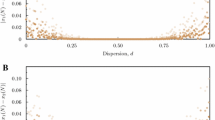Abstract.
Dispersal polymorphism and evolutionary branching of dispersal strategies has been found in several metapopulation models. The mechanism behind those findings has been temporal variation caused by cyclic or chaotic local dynamics, or temporally and spatially varying carrying capacities. We present a new mechanism: spatial heterogeneity in the sense of different patch types with sufficient proportions, and temporal variation caused by catastrophes. The model where this occurs is a generalization of the model by Gyllenberg and Metz (2001). Their model is a size-structured metapopulation model with infinitely many identical patches. We present a generalized version of their metapopulation model allowing for different types of patches. In structured population models, defining and computing fitness in polymorphic situations is, in general, difficult. We present an efficient method, which can be applied also to other structured population or metapopulation models.
Similar content being viewed by others
Author information
Authors and Affiliations
Additional information
Received: 6 March 2001 / Revised version: 12 February 2002 / Published online: 17 July 2002
Rights and permissions
About this article
Cite this article
Parvinen, K. Evolutionary branching of dispersal strategies in structured metapopulations. J Math Biol 45, 106–124 (2002). https://doi.org/10.1007/s002850200150
Issue Date:
DOI: https://doi.org/10.1007/s002850200150




